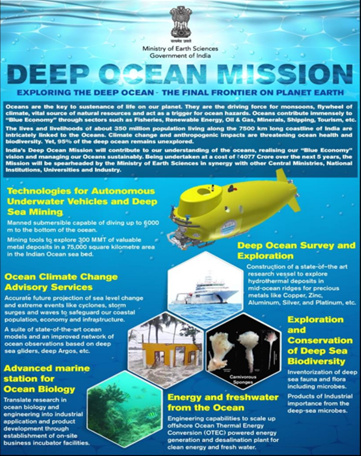

19th August 2025 (18 Topics)
Context:
India’s aquanauts successfully completed deep-sea dives up to 5000 metres, marking the nation’s first human mission into the deep ocean under the Samudrayaan Project of the Deep Ocean Mission.
Background and Significance
- Launched in September 2021 by Ministry of Earth Sciences (MoES).
- Outlay: ?4077 crore over 5 years.
- Aim: Develop technologies for sustainable harnessing of ocean resources – minerals, biodiversity, and energy.
- Strategic Vision: Strengthen Blue Economy, marine industries, and India’s role as a maritime power.
Major Components of Deep Ocean Mission 
- Technological Innovations
- Manned Submersible (MATSYA 6000): 3-person capacity, depth up to 6000 m, 12-hour mission capability, 96-hour emergency endurance.
- Integrated Mining System: Extraction of polymetallic nodules from Central Indian Ocean.
- Advanced welding & safety systems developed indigenously with ISRO support.
- Climate and Ocean Services
- Development of an Ocean Climate Change Advisory Service for long-term modelling.
- Enhances understanding of seasonal-decadal climate variability.
- Biodiversity Exploration
- Bio-prospecting of deep-sea flora, fauna, microbes.
- Research for marine fisheries and allied services.
- Resource Survey and Energy Development
- Mapping of polymetallic nodules and hydrothermal sulphides.
- Ocean Thermal Energy Conversion (OTEC) studies for renewable power and desalination.
- Advanced Marine Station for Ocean Biology
- Incubation hub for marine biotechnology and industrial products.
- Promotes marine-based industries under Blue Economy.
Samudrayaan Project – India’s Deep-Sea Leap
- Core focus: Human Occupied Vehicle (HOV) – MATSYA 6000.
- Built with titanium-alloy pressure hull and electron-beam welding technology.
- Successful dry & wet trials at 500 m, and manned dives at 5000 m in collaboration with France’s IFREMER (2025).
- Milestone: Over 100 kg cobalt-rich polymetallic nodules collected in the Andaman Sea.
Strategic and Scientific Relevance
- Blue Economy
- India’s 7517 km coastline, 1382 islands, and 2.2 million sq. km EEZ provide vast opportunities.
- Blue Economy projected to cross $100 billion contribution.
- Global Context
- Only a handful of nations (USA, Russia, Japan, China, France) have deep-sea submersible technology.
- Strengthens India’s position in International Seabed Authority (ISA)
- Sustainability Concerns
- Need for balance between resource exploitation and conservation.
- Mission aligns with UN SDG-14: Life Below Water.
Challenges
- Technological: Extreme pressure (600 bar), temperatures (-3°C), reliability of manned submersibles.
- Environmental: Risk to fragile deep-sea ecosystems, biodiversity loss.
- Regulatory: International Seabed Authority (ISA) yet to finalise commercial mining framework.
- Financial & Human Resources: High cost, requirement of skilled aquanauts, and maintenance.
Way Forward
- Strengthen indigenous R&D in deep-sea engineering and biotechnology.
- Enhance international collaborations (e.g., India–France cooperation on IFREMER).
- Establish a National Framework for Deep-Sea Mining Governance with environmental safeguards.
- Integrate Blue Economy strategy with coastal livelihood promotion, marine tourism, and sustainable fisheries.
- Continuous impact assessments to ensure compliance with UNCLOS and ISA guidelines


